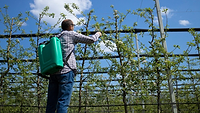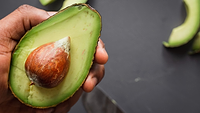Pesticides Found in 70 Percent of U.S. Produce

The Environmental Working Group (EWG) has released its annual Shopper’s Guide to Pesticides in Produce™ for 2022. In the guide, EWG compiles data from the U.S. Department of Agriculture (USDA) and the U.S. Food and Drug Administration (FDA) to determine what fruits and vegetables contain the most and least pesticide-contaminated produce in the U.S. EWG’s guide also includes its Dirty Dozen™ and Clean Fifteen™ lists, which provide a quick overview of the guide’s findings for consumers to reference. EWG reports that more than 70 percent of non-organic fresh produce sold in the U.S. contains residues of potentially harmful pesticides.
The data analyzed for the 2022 guide comes from USDA and FDA tests of 46 different types of produce in the years 2011–2020 (excluding pineapple data, which is from 2002). USDA does not sample every type of produce annually; each year USDA selects a subset of produce types to test. The most recent data includes test results of 44,702 samples of produce. USDA also does not test for all pesticides used in crop production. A notable pesticide that is not included in USDA tests is glyphosate, which is the most commonly used pesticide in the U.S.
Rankings are based on the percentage of samples containing pesticides, as well as the number and amount of pesticides on all samples and individual samples. EWG uses data from the most recent sampling period for each food. The guide’s full list ranks all 46 types of produce in descending order of detectible levels of pesticide residues.
EWG’s Dirty Dozen™
Of the 46 types of produce included in EWG’s analysis, the following are contaminated with the most pesticides:
- Strawberries
- Spinach
- Kale, collard, and mustard greens
- Nectarines
- Apples
- Grapes
- Bell and hot peppers
- Cherries
- Peaches
- Pears
- Celery
- Tomatoes.
Key findings:
- Several pepper samples contain high levels of residues for pesticides that can harm the nervous system: oxamyl, acephate, and chlorpyrifos. These pesticides are banned from use on some U.S. crops and banned completely in the EU.
- Over 90 percent of strawberry, apple, cherry, spinach, nectarine, and grape samples had detectible residues for two or more pesticides.
- Kale, collard, and mustard greens had detectible residues for 103 different pesticides. A single sample of kale, collard, and mustard greens contained residues for up to 21 pesticides.
- Hot peppers and bell peppers had detectible residues for 101 different pesticides.
- Spinach samples had 1.8 times as much pesticide residue by weight than any other crop, on average.
- DCPA, which is classified by the U.S. Environmental Protection Agency as a possible human carcinogen and is banned in the EU, is the most frequently detected pesticide in kale, collard, and mustard greens. Residues of two potentially neurotoxic pesticides—neonicotinoids and pyrethroids—were also found on these greens.
EWG’s Clean Fifteen™
- Avocados
- Sweet corn
- Pineapple
- Onions
- Papaya
- Sweet peas (frozen)
- Asparagus
- Honeydew melon
- Kiwi
- Cabbage
- Mushrooms
- Cantaloupe
- Mangoes
- Watermelon
- Sweet potatoes.
Key findings:
- Nearly 70 percent of Clean Fifteen produce had no detectible pesticide residues
- Less than 2 percent of avocado and sweet corn samples had detectible pesticide residues
- Approximately 5 percent of Clean Fifteen produce had detectible residues of two or more pesticides
- Avocados, sweet corn, pineapple, onions, papaya, and frozen sweet peas tested positive for three or fewer pesticides per sample.
Three vegetables that were present on the Clean Fifteen list in years prior have been removed from this year’s guide due to having not been tested by the FDA in six, seven, and 14 years, respectively: broccoli, cauliflower, and eggplant.
Looking for a reprint of this article?
From high-res PDFs to custom plaques, order your copy today!






